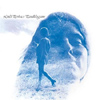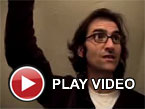Linda Perhacs, "Parallelograms"
 Since childhood Perhacs has composed music using elements from her visualization of sound (color frequencies, musical shapes, etc,...). This cult album from 1970 combines ethereal folk with flourishes of electronics and spacey jazz. Eight bonus tracks, fascinating notes, and sketches make this a worthwhile reissue.
Since childhood Perhacs has composed music using elements from her visualization of sound (color frequencies, musical shapes, etc,...). This cult album from 1970 combines ethereal folk with flourishes of electronics and spacey jazz. Eight bonus tracks, fascinating notes, and sketches make this a worthwhile reissue.
A glance at the cover of Parallelograms will bring the words "hippy" and "LSD" to mind. But take a closer look and you'll see that the beauty wandering the meadow in a mini-dress is wearing sensible shoes. The truth is that in the late 1960s everyone didn't drop-out and some people didn't need drugs to expand their mind. Take Linda Perhacs. She was a career-oriented dental hygienist in Beverly Hills when she met film composer Leonard Rosenman, and his wife, Kay, who recognized and encouraged her creativity. As Perhacs says, "even as a tiny child, I have seen musical tones and colors as twins (and they are twins vibrationally in physics). Along with this I would see complex chronological patterns that moved up and changed rapidly like Irish dancers." Is "vibrationally" a word? It is now.
At the time of meeting the Rosenman's, Perhacs was married to a like-minded sculptor and designer who shared her love of the getting out into the invigorating wildness of nature. Perhacs had homemade tapes of her "little campfire songs" and one listen to the song "Parallelograms" was enough for Leonard Rosenman to offer to produce an album for her. His liking for atonal sounds tempered her delicate musings. Perhacs wrote some new songs and recording was done at night while she kept her day job. "Dolphin" was inspired by diving in California. "Hey, Who Really Cares" (co-written with Oliver Nelson) would become the theme tune for the TV series Matt Lincoln. Meanwhile, in a not-uncommon tale, her record company failed to promote the album but, even worse, changed the running order and pressed the disc so badly that she threw her copy away. No one offered another deal so Perhacs concentrated on other things, like dental hygiene and going out to the country, presumably.
There's another picture of Linda Perhacs inside the booklet. Taken in 1995 she is glowing with health: her hair is dark, her teeth are dazzling white (no surprise there). Relaxed and happy in her white sweater and skirt she looks like I imagine Wonder Woman might look at the end of an idyllic vacation in Ireland! A clue to how she has survived in such fine fettle perhaps lies in the way that she has taken pain and disgust and turned them into something positive and uplifting. For example, her song "Paper Mountain Man" addresses a former lover who was too liberal with his love and "Porcelain Baked-Over Cast-Iron Wedding" is her response to her repulsion at the grandeur and sheer cost of Beverly Hills weddings. In Perhacs' hands, both sound like lovely songs with a slightly sharp edge. Clearly this is a woman who knows about balance and nature. Her honest quotes about music making and her non-trendy life have a sincerity and openness that are as refreshing and dignified as her music. Good vibrations; worth picking up.
samples



